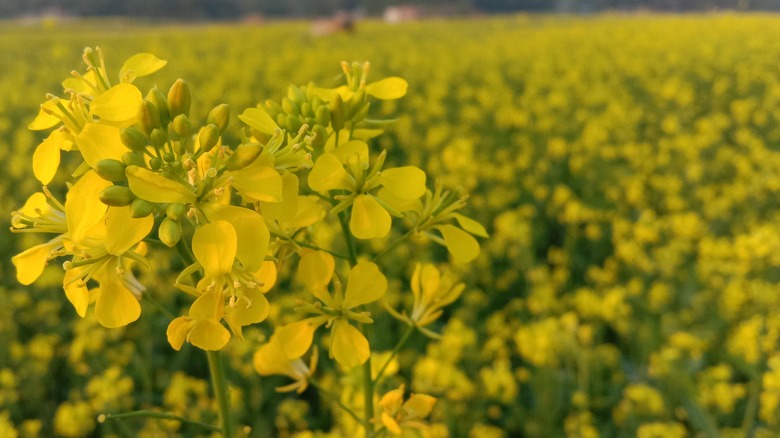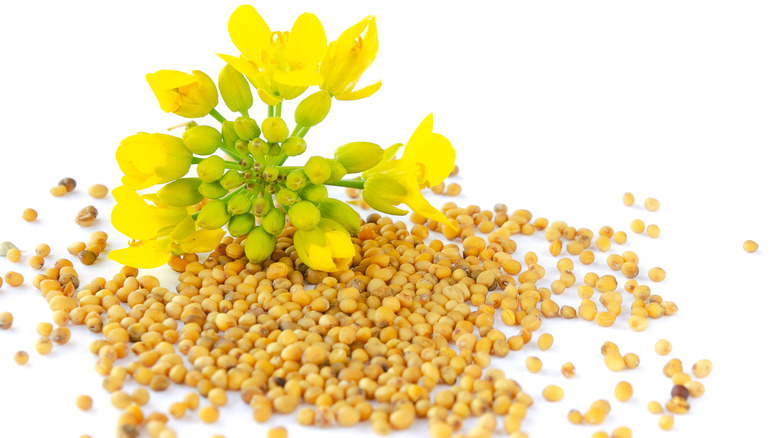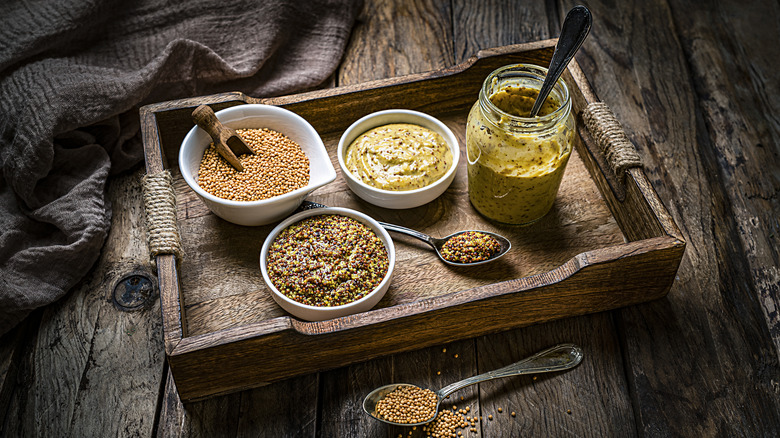The 2 Countries That Produce Most Of The World's Mustard
When you think of mustard, certain cuisines come almost immediately to mind, and you may assume they are, therefore, largely responsible for its production. The Germans enthusiastically top wurst and dip giant, soft pretzels into it; the French use it to flavor everything from dressings and glazes to marinades; the Dutch warm up over steaming bowls of mustard soup; and Americans are known to squeeze bright, mild yellow varieties onto all manner of grilled meats. While these countries may be most commonly associated with the condiment, mustard was first cultivated in the Indus Civilization of South Asia as early as 2500 B.C. — and yet none of these regions rank among the mustard plant's top producers today.
Although the exact ranking changes from one year to the next based on climate, soil conditions, and other factors, Nepal, Russia, and Canada are the contenders most commonly vying for the title of top mustard seed producer. According to the most recent data, Nepal is the current leader of the pack, having grown 27% of the world's mustard (via Helgi Library). Russia comes in second place, closely followed by Canada. So whether you're making an elevated tarragon remoulade sauce or breaking out the fancy mustard for deviled eggs, your mustard likely has unexpected roots.
Where mustard thrives and how it varies
With the stark differences in climate between Nepal and Russia, it may be surprising to see them topping production charts for the same crop. But the mustard plant, which is part of the Brassicaceae family, is a relatively easy crop to produce. It requires little more than regular sun; fertile, loamy soil; and growing season temperatures between roughly 35 and 75 degrees Fahrenheit.
While there are more than 40 different types of mustard plants, only two main plants are used in mustard production. The first is called sinapis alba — or yellow (or white) mustard. It's native to the Mediterranean, but today, it is grown around the world — this is the variety grown in Russia's largest mustard-producing district. The seeds harvested from the sinapis alba plant are the least spicy variety, and so naturally, they are the ones chosen to make the milder condiment varieties, like the yellow mustard we most commonly find in America.
The second mustard type comes from the brassica juncea plant and is also known by the names brown, black, and Indian mustard. Originally from the Himalayas, this plant is the most common type grown in Nepal today. Seeds from the brassica juneca plant are sharper and have a more intense flavor than those from the sinapis alba plant, and are typically used for mustards like French Dijon, hot German varieties, and Chinese mustard — those spicier varieties that ignite a delightful burning sensation in the nose when eaten.
How two plants produce such diverse condiments
While mustard seeds themselves vary in flavor, it's how mustard is made that most strongly impacts the final product. This is because, although the seeds contain a certain heat potential, the chemical reaction between mustard's enzymes and the liquid used to make the condiment determines its presentation. Acidity and temperature are two factors that can delay, shorten, expand, or reduce the spice level of a given mustard, as its enzymes are heat-sensitive and susceptible to erosion.
American yellow mustard, for example, is made from yellow mustard, water, and vinegar. Since this mustard is inherently mild, the liquids used don't enhance or modulate the burn. This product has an undeniable mustard flavor but is safe for the whole family to enjoy. Dijon mustard is traditionally made using the more intense brown mustard and white wine. The acid in the wine interacts with mustard enzymes and causes a delayed, prolonged burn — if you've eaten it before, you'll remember it's slow building burn. On the far end of the heat spectrum is hot mustard — made from intense brown mustard and cold water, which leaves enzymes intact. The result is a heat that hits quickly, building for several minutes — consume with caution.
Regardless of which type of mustard you prefer, unpacking the complexities that exist within mustard's history, production, and preparation enhances your appreciation of this common condiment. Thank your lucky stars for its initial cultivation — and all those who make these delicious varieties possible.



